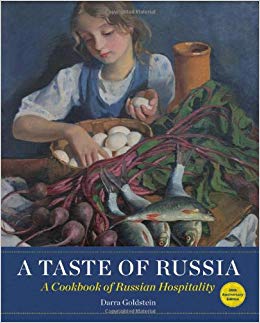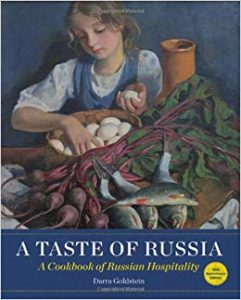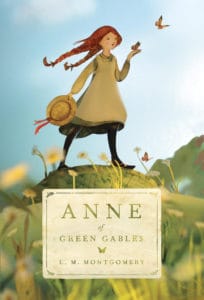Tag Archives:from the library

23
AugBinging on Great British Baking and Russian Pastry
 Gerry and I binge-watched at least four seasons of the Great British Baking Show this summer. It had been recommended and once I started binging and proselytizing about my new-found crush, I realized that, as with most other hit series, I was years late to the party. Especially this British one.
Gerry and I binge-watched at least four seasons of the Great British Baking Show this summer. It had been recommended and once I started binging and proselytizing about my new-found crush, I realized that, as with most other hit series, I was years late to the party. Especially this British one.
During one particular B-A-A-A-A-K-E which happened to be pastries, I thought of the favorite savory pastry that had captured my fancy over 25 years ago. It was the kulebiaka (or coulibiac) – a time-consuming Russian first course. The kulebiaka boasts a flaky, buttery pastry that envelopes a filling of either cabbage and chopped hardboiled eggs or salmon, rice and dill. My finished kulebiaka’s crust is garnished with leaves and a rope closure and rises and bakes to golden perfection.
Once sliced and served with sour cream, it is always met with ooohs and aaaahs across the room. Anton Chekhov wrote in his short story The Siren that “the kulebiaka must make your mouth water; it must lie there before you, a shameless temptation! You cut off a sizable slice and let your fingers play over it. When you bite into it, the butter drips from it like tears.”
I fantasized, recently of course, that Paul Hollywood would have swooned over one of my masterpieces, the kulebiaka. I might have had a handshake.
Long before I was awarded my master’s degree in library science (or MLS) from Boston’s Simmons College, I had returned to college in the late 1980s as an undergraduate. Years earlier I had left behind three years of academic work in History and Political Science at a California university to begin raising my family. A requirement for completing my degree with distinction from a Massachusetts state college was that I must complete more than half of the total required credits (120) at a Massachusetts school. Doing the easy math, I need to complete 150 total credits instead of the normal 120 for a bachelor’s degree. Lucky for me, I had more curiosity than 120 credits anyway.
My favorite courses that second time around were in Russian Studies, which of course fell right smack within my favorite academic areas of interest: history, literature and political science. For a minor in Russian Studies I was also required to take at least a year of Russian language and I memorized the Cyrillic alphabet forwards and backwards. My studies included a tour to the Soviet Union in 1990, a year before my hero USSR President Mikhail Gorbachev’s policies of glasnost and perestroika helped to dismantle the Soviet Union and communism.
My interest in Russia started many years before… as a very young child. Moving to Berkeley, California at the age of six, my family rented an apartment in a big house just three houses from my new elementary school. Our absent landlady was a large, hardy and hearty block of a Russian woman who was missing most of her right arm. Her infrequent visits, her Russian accent, and her exotic right arm fascinated me. That curiosity led me to other things Russian in my youth, including a book I read my senior year in high school, We the Living by Ayn Rand. It is one I credit with many influences in my life. The young, female protagonist in the book is named Kira. It was years later, after naming my youngest daughter with the Irish version of that name (Ciara and pronounced exactly the same), when I realized just how influential the book had been.
Returning from the study tour in the Soviet Union in 1990, I took up Russian cooking with an energetic passion. My graduation party from college in 1991 was a huge affair with over a hundred friends and family feasting on Russian food and drink. I enlisted the help of some of those friends who cooked and baked with me all week. I rented tables for the backyard and placed centerpieces of pitchers of lilacs, all donated from another friend’s garden. I hired a young Russian man named Sasha who appeared dressed in traditional Slavic costume. He spent the afternoon roaming the yard with his balalaika and entertaining the crowd with lovely Russian folk music. In addition, I contracted a slick-suited pianist named Vladimir who played music by Russian composers on the piano in my living room. It was a tremendously wonderful party and I smile again remembering it nearly three decades later.
So, following that pastry episode on the GBBS, I searched for my recipe books and came across some of my old favorites on my bookshelves, A La Russe: A Cookbook of Russian Hospitality by Darra Goldstein and the Art of Russian Cuisine by Anne Volokh. The copy of my favorite book, Russian Cooking, part of the Time-Life Cooking of the World Series I had collected in the 70s as a young wife, was missing. That book was the one from which I’d learned exactly how to assemble the kulebiaka, using the photographs over a two-page spread. To my surprise, not one of the Minuteman Libraries had a copy. Thankfully, I found over a dozen copies of Russian Cooking listed in the Massachusetts’ Commonwealth Catalog (or ComCat.) Although I could have requested one through Massachusetts library delivery, I eventually unearthed my own copy. I discovered the very worn and stained spiral-bound book of recipes and the accompanying hardcover in my basement, mixed in with a few other castaways.
Searching the library catalog, I found a more recent copy of Darra Goldstein’s book (published in 2013 as A Taste of Russia and I’ve added to our collection.) Her book is rich with recipes for Marinated Mushrooms, Baked Apple Charlotte, Baba au Rhum, and Siberian Dumplings. The recipe for Apricot Tart is one I memorized 25 years ago and use over and over again. Anne Volikh’s Art of Russian Cuisine is no longer in print, but several libraries have it on their shelves. She also includes a page of drawings illustrating assembly of the Kulebiaka and recipes from across the huge Russian and Soviet empires. Our library has a copy of Please to the Table by Anya von Kremen that includes recipes across the fifteen former republics of the Soviet Union.
If you’d like to learn the art and passion of Russian cooking, like the famed kulebiaka, there are many books in the Minuteman Library Network and across Massachusetts through ComCat. Or watch every episode of the Great British Baking Show and save those calories.
Charlotte Canelli is the Director of the Morrill Memorial Library in Norwood, Massachusetts. Read Charlotte’s column in the August 23, 2018 edition of the Norwood Transcript and Bulletin.

17
AugAnne of Green Gables: A Short Bit About Adopting an Older Child
 I fell in love with Anne of Green Gables while in college. I never read the books in high school, dismissing them because of the romance-y looking covers. I quickly realized my mistake and have read the series several times. I have visited Anne’s beloved Prince Edward Island, Canada. I attended the Anne play in Charlottetown, and was in heaven as I sat with my fellow Anne-fans, finishing up with a raspberry cordial at a nearby restaurant.
I fell in love with Anne of Green Gables while in college. I never read the books in high school, dismissing them because of the romance-y looking covers. I quickly realized my mistake and have read the series several times. I have visited Anne’s beloved Prince Edward Island, Canada. I attended the Anne play in Charlottetown, and was in heaven as I sat with my fellow Anne-fans, finishing up with a raspberry cordial at a nearby restaurant.
A mother and daughter were seated next to us, and the girl, probably about 14, was making it quite obvious that she didn’t want to be there and that the whole thing was “stupid.” Her poor mother finally had her moment when Anne’s beloved adopted guardian Matthew died suddenly of a heart attack. Soon, there were sniffles all around, and the young girl, ready to roast her mother, looked around, and sat back, quietly. I think she must have finally realized that hey, my mom’s not crazy. This is a thing; this Anne of Green Gables.
I relate this story because I remember thinking at the time, “of course my daughter will love all things Anne, especially if she’s adopted.” My husband and I had always toyed with the idea of adopting, knowing that there are so many children out there waiting for families. After having struggled with fertility issues for many years, we decided to adopt. If the child was a girl, she would probably be a lot like Anne; love books, have a great imagination, maybe get into a few scrapes here and there, but have a good heart and a great capacity to give and receive love.
Fast forward about 5 years… my husband receives a call from his great-aunt… “I know someone who has a little girl who is looking for a family.” This girl, who was just 6 years old, had been left by her birth mother at 2 years with a man who wasn’t her bio-dad and was now dying of Parkinson’s. It was an emergency situation; the man’s ex-sister-in-law (our introduction to the complex relationships involved with adoption) was anxious to find a place for her; the child was currently living with them. We hired a social worker and a lawyer, and began preparing for a child to move in with us.
We had just moved from a studio apartment to our first home, a 2 bedroom townhouse. In addition, this sister-in-law happened to live in the same town, so the little girl, who was attending Kindergarten, wouldn’t have to change schools. It seemed like an ideal situation: a couple desperately wanting to be parents, and a child who desperately needed a family. We began visiting with her and having her visit us. A pixie of a child, with huge blue eyes and close-cropped hair, she was adorable. She had a huge, toothy smile. She wanted to call us “Mom and Dad” right away. After a few months of visits and overnights, we took the big step and had her move in with us.
As we dealt with the lawyer, social worker, and adoption agency, we had to deal with something which, for me, was even bigger… my preconceived notions of adoption and parenting. The little girl was welcomed into our home and she seemed to feel comfortable there immediately, claiming this and that as “hers,” and generally making herself at home. My expectations of my adopted child being like Anne Shirley… an avid reader (like myself), a great imagination, a propensity for getting into scrapes, with a good heart and a great capacity to give and receive love, like the orphan starved for love that she was, were about to be challenged.
In Anne of Green Gables, Anne Shirley also made herself very comfortable when she first met Matthew and subsequently Marilla. She had her own gable room. Anne Shirley came with her own last name, as did Our Anne. She loathed and hated her red, red hair… hair that was to torment her throughout adolescence. Our Anne had extremely thick, curly hair which continues to torment her to this day, but which I personally think is beautiful. Like Anne Shirley, Our Anne had a vivid imagination… and like Anne Shirley in the scene where she is “confessing” to Marilla that she has lost Marilla’s precious brooch, Our Anne caused herself (and her parents) a lot of trouble with half-truths, fantasies, and outright fabrications. Our Anne’s “confessions” always seemed to be heard by someone in power (teacher, principal, etc.) and were always duly investigated. We had a rather strained but working relationship with the elementary school Our Anne was attending.
Our Anne had as much a capacity for getting into trouble as Anne Shirley did. The only difference is, Our Anne’s “scrapes” tended to be more like lesions… whatever she did was done wholeheartedly. There were bullying incidents, stealing incidents, and lots of behavioral incidents as this child tried to make her way in her new life. As an educator for over 20 years, I developed a very healthy respect for parents and the job of parenting. After some time, I also realized that I was being gifted with a unique perspective. Going through my daughter’s struggles with her gave me more understanding for the plight of adopted children in both their families and in classroom settings.
As much as Anne Shirley loved reading, our daughter despised it. We read to her every night (which she liked well enough) but our attempts to interest her in reading for its own sake were futile. I tried to convince her that reading would open up a whole new world for her… but, like Anne Shirley, Our Anne has her own mind and that mind was made up… books were “dust.” Sigh!
Anne Shirley was a love-starved child, as was Our Anne. However, their reactions to this issue were quite different. Anne Shirley was friendly, open and ready to love and be loved. Our daughter struggled to touch or be touched in any way, and didn’t know how to receive our love. This was such a tough thing to deal with, as I am an affectionate person. I had to satisfy my urge for affection with a pat on the shoulder or, most often, words of approbation.
Ten years later, our girl still struggles with some of these issues, and some new ones that keep cropping up. In the Anne of Green Gables series, Anne Shirley had some traumatic experiences that we know about, and probably some that we don’t. Our daughter had a truly traumatic early childhood and, to be expected, bears the scars to this day.
Adopting an older child taught me many valuable things: differences don’t have to sever us, we can both accept each other and celebrate our strengths, love is an action word… and it is not always easy to carry out, especially when it falls on deaf ears, the change in myself is as remarkable as the change in my daughter… I am much lighter on the preconceived notions and far more accepting of things as they come. And I have her to thank for that!
Recommended Reading:
Twenty Things Adopted Kids Wish Their Adoptive Parents Knew, by Sherrie Eldridge
The Post-Adoption Blues: Overcoming the Unforeseen Challenges of Adoption, by Karen J. Foli Ph.D. and John R. Thompson M.D.
Carla Howard is the Senior Circulation Assistant/Marketing and Media Assistant at the Morrill Memorial Library in Norwood, MA. Read Carla’s column in the August 16th issue of the Norwood Transcript and Bulletin.

9
AugIt Takes a Stretch
 You must have a favorite author. Someone you turn to when the rest of the world seems in chaos. Someone who is as comfortable to be with as your warm fuzzy slippers and a chair beside the fireplace. Perhaps it is Jamie Ford or Susan Meissner (two of my favorites) whose lyrical stories carry you back in time and make you fall in love with their characters. Or maybe you are addicted to Mary Higgins Clark or Louise Penny, and you cannot wait to settle down with their latest creations in your hands.
You must have a favorite author. Someone you turn to when the rest of the world seems in chaos. Someone who is as comfortable to be with as your warm fuzzy slippers and a chair beside the fireplace. Perhaps it is Jamie Ford or Susan Meissner (two of my favorites) whose lyrical stories carry you back in time and make you fall in love with their characters. Or maybe you are addicted to Mary Higgins Clark or Louise Penny, and you cannot wait to settle down with their latest creations in your hands.
While there is something magical and wonderful about those treasured authors, there is also something to be said for those books that you never ever thought you would read, and suddenly you do. Perhaps you’ve been astonished when your world expands after being stretched by a story or concept that greeted you when you dared to open a book that wasn’t part of your regular repertoire.
Every month I lead between four or five book clubs. I know! I should have my head examined. Still, I enjoy each and every one of them. When I started these groups, I surveyed my readers to see what type of books they loved to read. Many of them preferred mysteries. Hands down! Ironically, it is a rare month now when I select a mystery for a book club read. When it comes to this genre, I find there isn’t a lot to talk about in a group. Trust me, I’ve tried. Once you know “who done it,” the conversation tends to be a bit sparse. So I decided to choose a wide range of books and topics instead. And yes, I like to stretch my readers. Actually, I like to stretch myself, too. Sometimes this means I pick a total flop. This doesn’t bother me, though. We’ve had the most engaging conversations even when the book choice is a bust.
An example of this happened recently. The Spy Wore Red by Aline, Countess of the Romanones was a big hit with my book clubs. Everyone loved the suspense in this true life story of a World War II spy. With this success behind me, I decided a similar read entitled A Spy Among Friends by Ben Macintyre was appropriate. Boy, was I wrong. This was the story of a friendship between two spies, Kim Philby and Nicholas Elliott, and the years that Philby deceived both MI6 and the CIA. While we had a lot to discuss, the style of writing was rather dry for most of my readers. Nevertheless, we learned a lot about the circle of Cambridge University friends that the British intelligence recruited. Certainly, our minds were stretched.
Over the years my book clubbers have read a variety of genres that they might not have tried on their own. While we covered classics like Rebecca by Daphne Du Maurier and A Tree Grows in Brooklyn by Margaret Smith, we have also tried a western or two like True Grit by Charles Portis and post-apocalyptic science fiction like Station Eleven by Emily St. John Mandel. On occasion we jumped into young readers like Skating With the Statue of Liberty by Susan Lynn Meyer or The Book Thief by Markus Zusak. Why? Why not! Challenge accepted.
If you’re willing to stretch your definition of “good reads,” you might be drawn into another reader’s obsessions as well. I have a coworker who loves books about cats, any and all cats. Who am I kidding? I’m surrounded by coworkers who read cat books. To be honest, felines don’t always tickle my fancy as characters but, lo and behold, I found myself swept into a picture book called Caramba by Marie-Louise Gay when I saw it on my coworker’s desk. Now I’m addicted. I’m hoping Caramba, the cat who can’t fly, has many more stories to discover.
Likewise my husband has certain topics that fascinate him and I’m not sure if there’s any rhyme or reason for them. For a while Appalachian history captured his interest. For several nights in a row I fell asleep as he read out loud Night Comes to the Cumberlands by Harry M. Caudill. Soon I became intrigued by Appalachia as well. When Hillbilly Elegy by J.D. Vance was hot off the press, I raced to get a copy. Later, when my husband’s curiosity shifted to the topic of North Korea, I followed suit. A Thousand Miles to Freedom by Eunsun Kim and North Korea Undercover by John Sweeney are two books I would never have touched without my husband’s influence. It seems that other people’s obsessions are catchy.
Truth be told, I enjoy being stretched. I bet you do too! In the words of Charles Scribner, “Reading is a means of thinking with another person’s mind; it forces you to stretch your own.” The only problem is finding enough time to fit it all in. I’d highly recommend trying something completely new. You might even win a prize if you take the opportunity to fill out our Summer Reader’s Bingo in the process. Consider some of the categories: “A Book With a Beach Setting,” “A Book Set in Winter,” or “A Book With a Food Theme.” Go ahead… give it a chance. What have you got to lose?
Nancy Ling is the Outreach Librarian at the Morrill Memorial Library in Norwood, Massachusetts. Read Nancy’s column in the August 9th issue of the Norwood Transcript and Bulletin.

2
AugPolo, Picnics, and People Watching
 Pop quiz: Where can you show off your favorite sundress–or shorts, sip champagne–or soda, and stroll around an enormous field tamping down divots while kids cavort alongside canines, just over an hour away? (Hint: horses are involved.) Answer… at the Newport International Polo grounds in Portsmouth, RI. When friends invited us to join their party for an evening of polo this past Saturday I was all in, especially when I found out my four-footed companion was also welcome.
Pop quiz: Where can you show off your favorite sundress–or shorts, sip champagne–or soda, and stroll around an enormous field tamping down divots while kids cavort alongside canines, just over an hour away? (Hint: horses are involved.) Answer… at the Newport International Polo grounds in Portsmouth, RI. When friends invited us to join their party for an evening of polo this past Saturday I was all in, especially when I found out my four-footed companion was also welcome.
For over 130 years, polo matches have been among Newport’s grandest and most popular traditions–a legacy from the Gilded Age. I’m not the only Morrill Memorial Library staff member, it appears, to experience its charms. Hearing that I was going to watch USA take on Ireland the following day, Lydia, who oversees the excellent Technical Services Dept. in the fourth floor “stucco tower,” said “You’ll love it!” and suggested I bring along the library’s brand new picnic basket.
Among the Norwood Library’s circulating collection of non-traditional items, aka the “library of things,” is a woven, gingham-lined picnic hamper complete with stakes for securing your blanket, a paperback of picnic recipes, and a variety of wine accessories. I added some pasta and pesto salad, two bottles of vino—strictly to test out the corkscrew and spout, of course–grabbed a couple of lawn chairs, and hit the road.
70 minutes later, approaching the linden tree- and fieldstone wall-lined entrance to historic Glen Farm, we caught the strains of Irish music and the heady aroma of horses and grilling hamburgers. Our hosts had thoughtfully reserved a tailgate spot, canvas awning included, and were firing up the barby. If you missed the online registration for one of these coveted spaces back in January, not to worry. Pony up $15 and you can park your car as well as yourself and your cooler mere yards from the action.
The pre-polo festivities—a promenade around the grassy pitch the size of nine football fields—are part of the fun. Some spectators really get into the spirit. Attired in green, orange, and white, one group displayed their unbridled patriotism by planting a dozen little flags of Ireland in the turf next to a beautiful Irish picnic blanket. No sign of soda bread but the Guinness was flowing freely.
It’s all about the people and pup watching. Observing a cameraman crouched down pointing his oversize lens toward us, I instinctively straightened up. Wait, was he actually zooming in on my companion’s well-turned ankle? But no, his subject appeared to be my rather comical-looking, though much beloved, hound.
At 5:00 sharp the mounted polo ponies–more like 1,000 lb. thoroughbreds–entered the pitch and the players were introduced. We stood for the Irish and American national anthems, sent up a rousing cheer, and the game was on! Of the four home team competitors three were women, including a father/daughter duo. Players score by driving a solid white ball into the opposing team’s goal using a long-handled mallet. The match is comprised of six 7-minute periods, or chukkas, between which tired mounts are substituted for fresh ones. The action is fast and furious.
During half-time, spectators of all sizes and breeds swarm the field in the traditional divot-dance to flatten down the sod displaced by horseshoes. Just before play resumed, an Australian sheep dog cut loose and charged back onto the pitch in a misguided attempt to herd the flock. The straight-shooting British announcer (“There was no one in front of the goal and she still missed the shot—inconceivable!”) was not amused. The disgraced dog owner remained anonymous.
We noshed on your basic summer fare–burgers, franks, and salad—while our neighbors nibbled on bacon-wrapped scallops and deviled eggs. Newport Polo attracts a certain champagne and caviar clientele, after all; the queue for Veuve Clicquot was at least as long as the line for the porta-potties.
After a hard-fought contest, Team USA prevailed 8-7. The crowd then lined the perimeter of the pitch to high five the riders as they made their final circuit. Momentarily distracted, I failed to notice my little leashed buddy had scaled the low barrier to participate in the celebratory send-off. Somehow I managed to save him from certain death—or at least a badly bruised paw—a nanosecond before the horses thundered past. I opted to forgo the autograph signing, champagne toast and trophy presentation, deciding I’d had enough excitement for one day.
From The Golden Summers—An Antic History of Newport by Richard O’Connor, I learned that polo was first introduced to the United States in Newport, at the Westchester Polo Club, in 1876. Polo originated in Persia (modern-day Iran) sometime between the 6th century BC and the 1st century AD. Initially it was a training game for the cavalry, often the king’s guard or other elite troops. The sport is now played in 77 countries, with more than 275 polo clubs registered with the U.S. Polo Association.
For delving into the finer points of the game, I recommend reading As to Polo by William Cameron Forbes. Former owner of the Forbes Estate recently purchased by the Town of Norwood, the author hosted matches on the grounds, where his favorite polo pony is buried. The Minuteman Library Network also carries The Polo Primer: a Guide for Players and Spectators by Steven D. Price, as well as Allan Forbes’s Sport in Norfolk County. But to experience polo up close and personal, saddle up and head to the City by the Sea on any Saturday afternoon from now through September. And the next time you’re in the library, “chukka” out the picnic basket and all the other fun and functional items we lend for free, including a set of backyard horseshoes.
April Cushing is the Adult and Information Services Supervisor at the Morrill Memorial Library in Norwood, Mass. Read April’s column in the August 2nd edition of the Norwood Transcript & Bulletin.

26
JulChill Out, New England
 We all know that one of the great benefits of living in New England is that we get to experience all the seasons. Our iconic foliage draws busloads of tourists every autumn, we usually get to have a white winter holiday season, and our landscape becomes furiously and gloriously alive every spring. As a result, our New England summers can feel all too brief, and many residents look forward to summer all the rest of the year.
We all know that one of the great benefits of living in New England is that we get to experience all the seasons. Our iconic foliage draws busloads of tourists every autumn, we usually get to have a white winter holiday season, and our landscape becomes furiously and gloriously alive every spring. As a result, our New England summers can feel all too brief, and many residents look forward to summer all the rest of the year.
While we’re busy bundling up for the other seasons though, we can sometimes forget just how hot and humid our New England summers can be. Heat waves seem to surprise us because they don’t happen very often in the course of a year – remember that stretch of 90+ degree heat a few weeks ago? Brutal, right? And no wonder we feel this way – in the course of June 2018 we went from chilly spring temperatures in the 40s to blazing 92F, according to AccuWeather.com. That’s a pretty big difference, especially after what seemed like a prolonged winter.
I’m fully aware that we don’t deal with nearly the temperature extremes experienced in other parts of the United States or the world. For instance, according to Weather.com the city of Quriyat in Oman in the Middle East just broke a world record for the highest low temperature in a 24-hour period, a whopping 108.7F. However, New England is quite humid, and therefore we tend to “feel” temperatures more acutely. In the course of a year, our weather changes from -40F to over 100F, with some areas of our region experiencing temperatures more extreme in either direction. From freezing pipes and frost heaves to the baking sun and high humidity, our roads and buildings have to stand up to a lot.
At this point, you’re probably asking yourself if I’m seriously writing an article about the weather. (In May she wrote about statistics and algorithms in dating apps, and this month it’s the weather? Does this lady even get out?) Fooled you! I’m actually writing about how to keep cool and comfy in the summer without air conditioning at home. On some level we’re all getting used to air conditioning in public buildings, but as long as you don’t have a health condition that necessitates cool temps, do you need to invest in air conditioning at home in the Northeast?
There are some good reasons to go without AC if you can help it. Lowering your electric bill is a good motivation, since once you turn on the AC unit there’s a strong temptation to leave it running for most of the day. The cost of an air conditioner can also be prohibitive, as well as the hassle of properly installing the unit. Also, there’s a lot of joy in hearing birdsong and other sounds of summer coming through the window, which is drowned out by the chugging of an air conditioner. Plus, there’s the principle of the matter – there’s something perverse about turning on an air conditioner for a small amount of comfort when human activity is responsible for rising global temperatures in the first place.
Passive cooling measures are easier than you think; they just take a little bit of planning. It’s an awful feeling to get to work and realize a storm is heading your way on a day you decided to leave some windows open to catch the breeze. A few easy tips include: close the shades during the day, especially on the sides of your house that catch the sun; close the windows on the sunny sides of your house, though you may decide to leave windows cracked on the shady sides of your house if cool air is blowing in; as soon as the evening temperature drops lower than the temperature inside your house, open those windows and enjoy the night breeze; use window fans to draw in extra cool night air if the day has been especially hot, making sure to crack another window to help the fan work as efficiently as possible; avoid stove or oven cooking if you can help it, and instead eat cold foods like salad or use a slow cooker to keep from heating up your kitchen. For even more practical tips for keeping cool and conserving energy, especially if you’re planning a remodel project, check out these books from the library: The Carbon Buster’s Home Energy Handbook by Godo Stoyke, The Energy Wise Home by Jeff Dondero, True Green Home by Kim McKay, and This Cold House by Colin Smith.
We have lots of cookbooks with slow cooker recipes. Browse our cookbook section on the Mezzanine level next time you’re in, and keep an eye out for titles like The Everything Healthy Slow Cooker Cookbook, The Slow Cooker Revolution, and The Chef and the Slow Cooker.
Swim, wear loose fitting clothing, eat ice cream – and when we hit a streak of 90+ degree weather and all else fails – come to the library. We have free air conditioning, and lots of books and great programs all summer long.
Liz Reed is an Adult and Information Services Librarian at the Morrill Memorial Library in Norwood, Massachusetts. Read Liz’s column in the July 26, 2018 issue of the Norwood Transcript and Bulletin.
